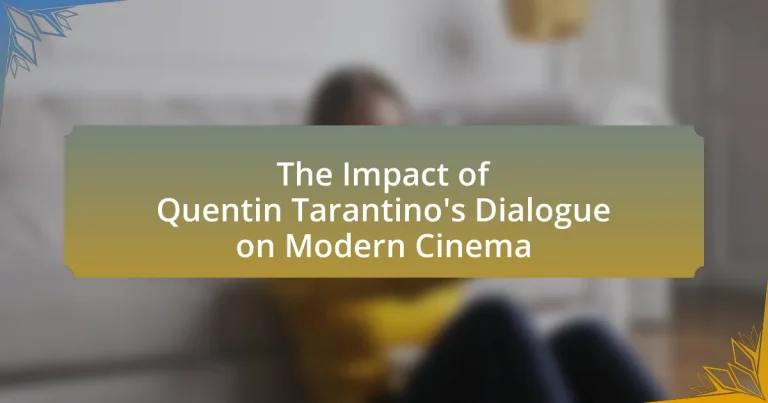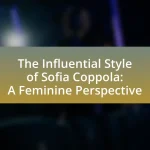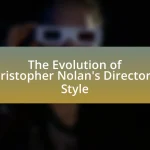Quentin Tarantino’s dialogue has significantly influenced modern cinema by revolutionizing character development and narrative structure through its sharp wit, cultural references, and non-linear storytelling. The article explores the evolution of Tarantino’s dialogue style, highlighting key characteristics and its impact on contemporary filmmakers. It examines how dialogue contributes to character depth, builds tension, and shapes audience expectations, while also discussing the challenges filmmakers face when attempting to replicate his unique approach. Notable examples from Tarantino’s films illustrate the effectiveness of his dialogue in enhancing storytelling and engaging viewers.
What is the significance of Quentin Tarantino’s dialogue in modern cinema?
Quentin Tarantino’s dialogue is significant in modern cinema because it revolutionizes character development and narrative structure. His unique style blends sharp wit, cultural references, and non-linear storytelling, which enhances the emotional depth and realism of characters. For instance, in “Pulp Fiction,” the dialogue not only drives the plot but also reveals the complexities of the characters, making them memorable and relatable. This approach has influenced countless filmmakers, leading to a shift in how dialogue is perceived and utilized in screenwriting, emphasizing authenticity and engagement over traditional exposition.
How has Tarantino’s dialogue style evolved over his career?
Quentin Tarantino’s dialogue style has evolved from sharp, pop culture-infused exchanges to more complex, character-driven conversations. In his early works, such as “Reservoir Dogs” and “Pulp Fiction,” Tarantino’s dialogue was characterized by witty banter and non-linear storytelling, often featuring characters discussing mundane topics that revealed their personalities and motivations. As his career progressed, particularly in films like “Inglourious Basterds” and “Once Upon a Time in Hollywood,” his dialogue became more layered, incorporating historical context and deeper emotional resonance, showcasing a greater emphasis on character development and thematic depth. This evolution reflects Tarantino’s growing mastery of dialogue as a tool for storytelling, enhancing the overall impact of his films on modern cinema.
What are the key characteristics of Tarantino’s dialogue?
Tarantino’s dialogue is characterized by its sharp wit, non-linear storytelling, and cultural references. The sharp wit often includes clever wordplay and unexpected humor, which engages audiences and adds depth to character interactions. Non-linear storytelling is evident in how characters discuss events that may not occur in chronological order, creating intrigue and tension. Cultural references permeate his dialogue, drawing from various genres, films, and pop culture, which enriches the narrative and resonates with viewers familiar with those references. These characteristics contribute to a distinctive style that has significantly influenced modern cinema, making dialogue a central element of his storytelling.
How does Tarantino’s dialogue reflect his influences?
Tarantino’s dialogue reflects his influences through its distinctive blend of pop culture references, sharp wit, and non-linear storytelling. His work draws heavily from genres such as blaxploitation, spaghetti westerns, and classic crime films, which is evident in the way characters engage in lengthy, often tangential conversations that reveal their personalities and motivations. For instance, the dialogue in “Pulp Fiction” showcases his ability to intertwine mundane topics with intense situations, a technique inspired by the works of filmmakers like Martin Scorsese and Jean-Luc Godard. This approach not only pays homage to his cinematic influences but also reshapes narrative structure in modern cinema, making dialogue a pivotal element in character development and plot progression.
Why is dialogue important in film storytelling?
Dialogue is important in film storytelling because it serves as a primary means of character development and plot advancement. Through dialogue, filmmakers convey emotions, establish relationships, and reveal motivations, which are essential for audience engagement. For instance, Quentin Tarantino’s films exemplify this by using sharp, witty dialogue that not only entertains but also deepens character complexity and drives the narrative forward. Studies have shown that well-crafted dialogue can enhance viewer immersion and emotional connection, making it a critical element in effective storytelling.
How does dialogue contribute to character development?
Dialogue significantly contributes to character development by revealing a character’s thoughts, motivations, and relationships through their spoken words. In Quentin Tarantino’s films, for instance, characters often engage in lengthy conversations that expose their personalities, beliefs, and conflicts, allowing the audience to understand their complexities. This technique not only enhances character depth but also drives the narrative forward, as seen in films like “Pulp Fiction,” where the dialogue intricately weaves character backstories and dynamics into the plot. The effectiveness of dialogue in character development is supported by narrative theory, which emphasizes that character actions and speech are crucial for audience engagement and emotional investment.
What role does dialogue play in building tension and conflict?
Dialogue serves as a critical mechanism for building tension and conflict in storytelling. In Quentin Tarantino’s films, dialogue often reveals character motivations and underlying tensions, creating an atmosphere ripe for conflict. For instance, in “Reservoir Dogs,” the intense conversations among characters escalate the stakes and reveal their conflicting loyalties, heightening suspense. This technique is supported by narrative theory, which posits that dialogue can serve as a catalyst for conflict by exposing differing perspectives and emotional states, thereby engaging the audience and driving the plot forward.
How has Quentin Tarantino’s dialogue influenced contemporary filmmakers?
Quentin Tarantino’s dialogue has significantly influenced contemporary filmmakers by emphasizing sharp, witty exchanges and non-linear storytelling. His unique style, characterized by pop culture references and extended conversations, has inspired directors like Edgar Wright and David O. Russell to adopt similar techniques in their films. For instance, Tarantino’s work in “Pulp Fiction” showcased how dialogue can drive narrative and character development, leading to a trend where filmmakers prioritize dialogue as a central element of storytelling. This impact is evident in films such as “Baby Driver” and “Silver Linings Playbook,” where dialogue plays a crucial role in shaping the viewer’s experience and engagement.
What techniques have filmmakers adopted from Tarantino’s dialogue?
Filmmakers have adopted several techniques from Quentin Tarantino’s dialogue, including non-linear storytelling, pop culture references, and extended conversations that blend humor with tension. Non-linear storytelling allows filmmakers to create complex narratives that engage audiences, as seen in Tarantino’s “Pulp Fiction,” which rearranges the timeline to enhance suspense. The use of pop culture references adds a layer of relatability and authenticity to characters, a technique evident in films like “The Hateful Eight.” Additionally, the incorporation of lengthy, engaging dialogues that reveal character depth and build tension has influenced many directors, as demonstrated in films such as “Knives Out.” These techniques have reshaped modern cinema by encouraging a more dynamic approach to storytelling and character development.
How do modern films emulate Tarantino’s use of pop culture references?
Modern films emulate Tarantino’s use of pop culture references by incorporating eclectic cultural elements to create a layered narrative and establish character depth. Filmmakers often reference iconic movies, music, and television shows, mirroring Tarantino’s technique of blending high and low culture to evoke nostalgia and engage audiences. For instance, films like “Ready Player One” and “Stranger Things” utilize a plethora of 1980s pop culture references, similar to Tarantino’s homage to various genres and eras, which enhances the storytelling and resonates with viewers familiar with those cultural touchstones. This approach not only pays tribute to past influences but also enriches the film’s context, making it more relatable and engaging for contemporary audiences.
In what ways has Tarantino’s dialogue changed audience expectations?
Tarantino’s dialogue has changed audience expectations by elevating the importance of conversational authenticity and cultural references in film. His unique style, characterized by sharp wit, non-linear storytelling, and pop culture allusions, has set a new standard for dialogue that prioritizes character depth and realism. For instance, in “Pulp Fiction,” the mundane conversations between characters serve to develop their personalities and create tension, which has influenced how audiences perceive dialogue as a critical element of storytelling rather than mere exposition. This shift has led viewers to expect more engaging and layered interactions in films, prompting filmmakers to adopt similar techniques to meet these heightened expectations.
What are some notable examples of Tarantino’s dialogue in his films?
Notable examples of Quentin Tarantino’s dialogue include the “Royale with Cheese” conversation in “Pulp Fiction,” where characters discuss cultural differences in fast food, and the “I’m gonna make him an offer he can’t refuse” scene in “Inglourious Basterds,” which showcases tension through casual conversation. These dialogues exemplify Tarantino’s unique ability to blend mundane topics with intense themes, creating memorable and impactful moments. The dialogue in “Pulp Fiction” has been widely analyzed for its rhythm and authenticity, contributing to the film’s critical acclaim and cultural significance.
How does the dialogue in “Pulp Fiction” exemplify his style?
The dialogue in “Pulp Fiction” exemplifies Quentin Tarantino’s style through its sharp wit, non-linear storytelling, and cultural references. Tarantino’s characters engage in lengthy conversations that often blend mundane topics with profound themes, showcasing his ability to create tension and humor simultaneously. For instance, the famous “Royale with Cheese” scene illustrates how trivial discussions can reveal character depth and set the tone for the film. This distinctive approach to dialogue has influenced modern cinema by encouraging filmmakers to prioritize character-driven conversations that enhance narrative complexity and engage audiences.
What makes the dialogue in “Inglourious Basterds” stand out?
The dialogue in “Inglourious Basterds” stands out due to its sharp wit, tension-building exchanges, and multilingual elements that enhance character development and thematic depth. Quentin Tarantino employs lengthy, suspenseful conversations that often serve as a prelude to violence, exemplified in the opening scene with Colonel Hans Landa, where the dialogue intricately reveals his manipulative nature. Additionally, the use of multiple languages—primarily English, French, and German—adds authenticity and complexity, allowing characters to express their identities and motivations more vividly. This approach not only captivates the audience but also reflects Tarantino’s mastery in blending dialogue with narrative, making it a significant influence on modern cinema.
What challenges do filmmakers face when trying to replicate Tarantino’s dialogue style?
Filmmakers face significant challenges when trying to replicate Quentin Tarantino’s dialogue style, primarily due to its unique blend of rhythm, cultural references, and character-driven storytelling. Tarantino’s dialogue is characterized by its sharp wit and non-linear structure, which requires a deep understanding of character motivations and relationships. Additionally, the incorporation of pop culture references demands a nuanced grasp of the cultural landscape, making it difficult for filmmakers to achieve authenticity without sounding forced or derivative. The challenge is further compounded by the need for actors to deliver lines with the same level of charisma and timing that Tarantino’s characters exhibit, which can be difficult to replicate.
Why is it difficult to capture the essence of Tarantino’s dialogue?
Capturing the essence of Tarantino’s dialogue is difficult due to its unique blend of pop culture references, non-linear storytelling, and character-driven exchanges. Tarantino’s dialogue often reflects a deep understanding of genre conventions and subverts them, making it challenging to replicate without losing its authenticity. Additionally, the rhythm and cadence of his writing, which often includes long monologues and sharp wit, require a nuanced delivery that is hard to emulate. The complexity of his characters and their interactions further complicates the task, as each line is crafted to reveal layers of personality and motivation, making it essential to grasp the context and subtext inherent in his work.
What pitfalls should filmmakers avoid when writing dialogue inspired by Tarantino?
Filmmakers should avoid excessive mimicry of Tarantino’s unique style, as it can lead to unoriginal and clichéd dialogue. Tarantino’s dialogue is characterized by its sharp wit, cultural references, and naturalistic flow, which can be difficult to replicate authentically. When filmmakers attempt to copy his style without understanding the underlying context or character motivations, the dialogue often feels forced and inauthentic. Additionally, filmmakers should steer clear of overindulgence in pop culture references, as this can date the dialogue and alienate audiences who may not share the same cultural touchstones. Lastly, filmmakers must be cautious of creating dialogue that is overly verbose; Tarantino’s effective use of brevity and subtext can be lost if filmmakers do not balance dialogue with action and pacing.
How can filmmakers maintain originality while drawing inspiration from Tarantino?
Filmmakers can maintain originality while drawing inspiration from Tarantino by infusing their unique voice and perspective into their narratives. This involves analyzing Tarantino’s techniques, such as non-linear storytelling and sharp dialogue, and then applying those elements in a way that reflects their own experiences and cultural context. For instance, filmmakers can create original characters that resonate with their personal backgrounds, thereby differentiating their work from Tarantino’s while still utilizing similar stylistic choices. This approach is supported by the fact that many successful directors, like Edgar Wright and Greta Gerwig, have cited Tarantino’s influence but have carved out distinct identities through their storytelling methods and thematic focuses.
What practical tips can filmmakers use to enhance their dialogue writing?
Filmmakers can enhance their dialogue writing by focusing on authenticity, subtext, and character voice. Authenticity ensures that dialogue reflects real speech patterns, making characters relatable and believable. Subtext allows for deeper meaning beneath the spoken words, creating tension and engagement; for instance, Tarantino often uses subtext to convey character motivations without explicit statements. Additionally, distinct character voices help differentiate personalities and make interactions more dynamic; Tarantino’s characters often have unique speech styles that reflect their backgrounds and motivations. These techniques contribute to memorable and impactful dialogue, as evidenced by the critical acclaim of Tarantino’s films, which often highlight the importance of well-crafted dialogue in storytelling.
How can understanding character voice improve dialogue quality?
Understanding character voice enhances dialogue quality by ensuring that each character’s speech reflects their unique personality, background, and motivations. This specificity allows for more authentic interactions, making the dialogue feel natural and engaging. For instance, Quentin Tarantino’s films exemplify this, as his characters often have distinct voices that contribute to their development and the overall narrative. By analyzing how Tarantino crafts dialogue that aligns with character voice, one can see that it not only drives the plot but also deepens audience connection, as viewers can relate to the characters on a more personal level.
What exercises can help writers develop their dialogue skills?
Writers can develop their dialogue skills through exercises such as writing character interviews, practicing dialogue-only scenes, and analyzing scripts from films, particularly those by Quentin Tarantino. Character interviews involve creating a list of questions and answering them in the voice of the character, which helps in understanding their motivations and speech patterns. Writing dialogue-only scenes focuses on conveying emotion and plot without descriptive text, enhancing the ability to create authentic conversations. Analyzing scripts, especially Tarantino’s, reveals techniques like subtext and rhythm, which are crucial for effective dialogue. These exercises are validated by the emphasis on character-driven storytelling in modern cinema, where dialogue plays a pivotal role in character development and plot advancement.


